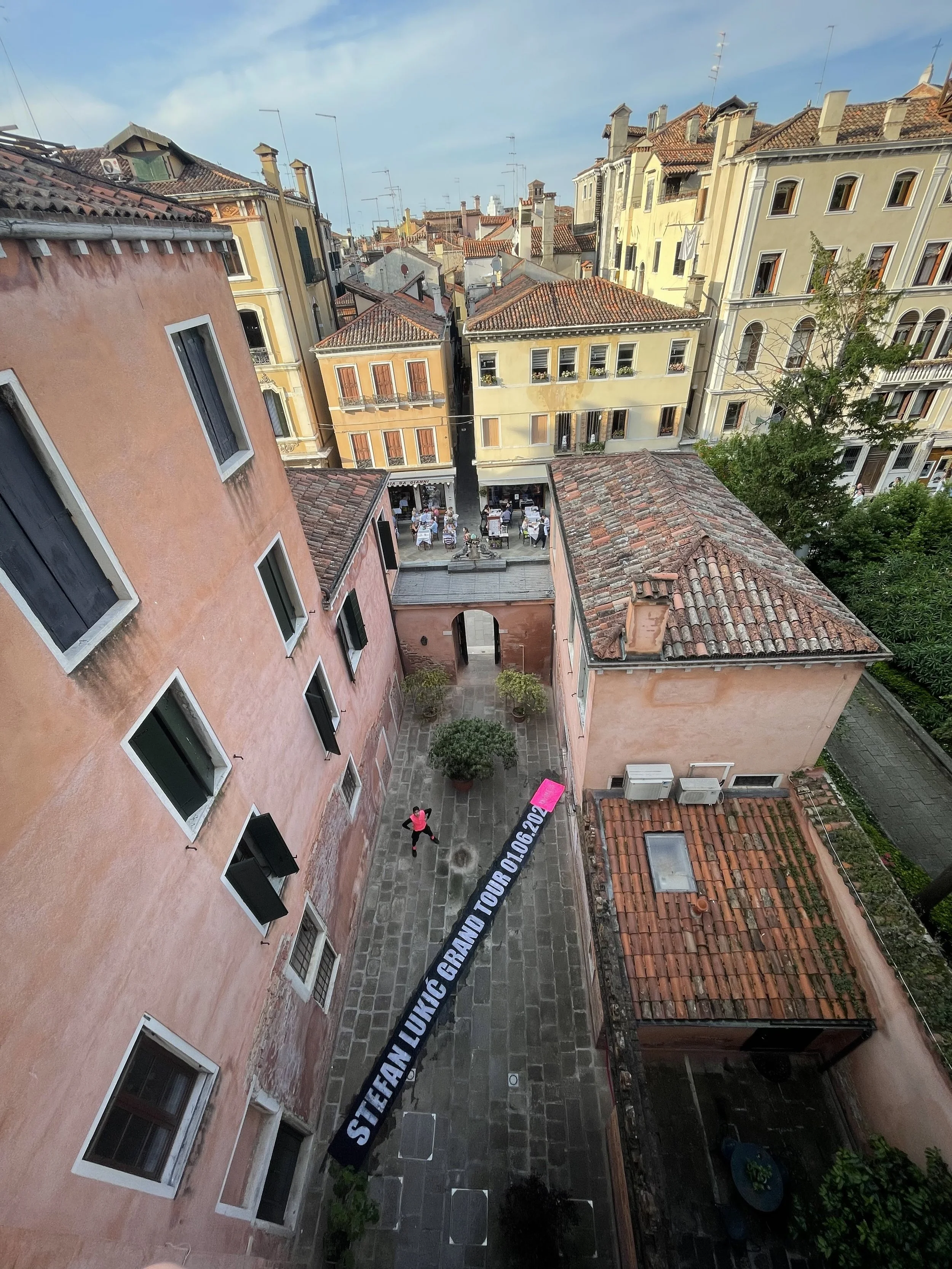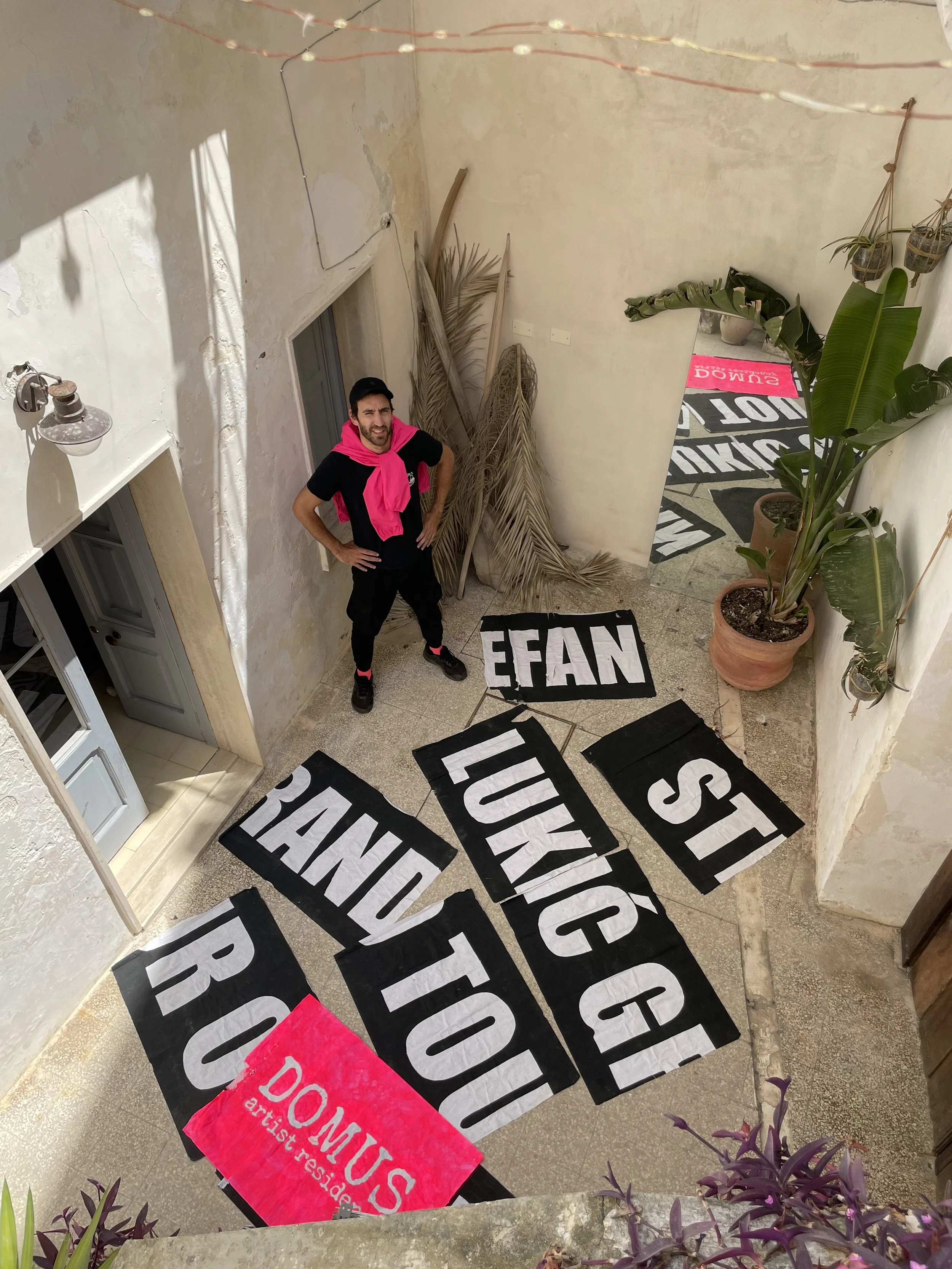STEFAN LUKIĆ
Resident of June 2025
Stefan Lukić is a Serbian visual and performance artist whose vision is to capture the universal state of being in transit, migration, and constant movement. He is intrigued by the role of travelers and eyewitnesses and strives to represent them through his art. Roads, distances, and we as travelers become the connection between places, memories, ideas, people, life, love, human struggle, and death. Stefan Lukić’s paintings almost always speak of the process of searching and transitional points — expressing feelings of constant flux, a movement that never ends. He reminds us that it is all about the journey, not the destination. He emphasizes the act of wandering the road more than the act of arriving. In his paintings, we discover more about how we are seeking, and less about what we are seeking.
Performances by Stefan Lukić — or as he calls them, drawing-events — are similar to his paintings. They are more raw, unfiltered like life itself, without any mediation, embracing all the unpredictable situations that may arise.
Stefan Lukić completed his Master’s studies at the Faculty of Fine Arts in Belgrade in 2022. He graduated from the Faculty of Applied Arts in Belgrade in 2018 and completed his third year of studies at the Academy of Fine Arts (ENSBA) in Paris in 2017. He was a resident at “Cité internationale des arts”, Paris, France (2024); ”Kunstepidemin”, Gothenburg, Sweden (2021); and “Homesession Art Space“, Barcelona, Spain (2021). He completed a master class at the Royal Academy (Rijksakademie), Amsterdam, Netherlands in 2019. He participated in the 13th Performance Festival in Gothenburg, Sweden, and the 31st Memorial of Nadežda Petrović in 2022. He was a finalist for the “Mangelos Award for Contemporary Art“ in 2021 and received the painting award from the Faculty of Applied Arts in 2016.
He has had several solo exhibitions, including: “Capital Offense”, Quattro, Milan, Italy (2025); “24/7”, Gothenburg, Sweden (2021); “Tram Called Desire – The First Round in Barcelona”, Barcelona, Spain (2021); “Second Round in Monte Carlo”, Monte Carlo, Monaco (2021); “Size Does (Not) Matter”, Catch 22, Belgrade, Serbia (2021); “As Far as My Legs Will Carry Me”, Dobrinjska 5, Belgrade, Serbia (2020); “Interspace”, U10 Art Space, Belgrade, Serbia (2018); “YUGOnostalgia”, National Theatre, Užice (2017); and “Face and Reverse”, National Museum, Kragujevac, Serbia (2016).
He has participated in group exhibitions in Paris, Belgrade, Novi Sad, Niš, and Kragujevac. He currently lives and works in Paris, France.
According to Pliny the Elder, the ancient painter Apelles of Kos once said “not a day without a line",” alluding to the idea that if one strives for success, one have to “draw a line” every day. In other words, you have to do something every day. Countless lines, days, successful and unsuccessful times have passed since this wise saying, and today we live in a system that prioritises the ideas of success, achievement and profit, while the possibility of idleness (or the enjoyment of rest) is excluded in practically all areas. In our time, even leisure has become a kind of work — a form of labour that is often referred to on social media as “serious digital leisure” (Spracklen 2015).
Take, for example, the continuous work of influencers who tirelessly offer us this or that product or brand through their posts and content — always in a way that seems more like a friendly recommendation than a paid advert. While they (have to) live by the philosophy of “not a day without a post" - because there's no place to stop; a day without a post is a day without reach, without profit, without new followers and further promotional offers — others also (have to) fulfil demanding standards in different areas and industries. In other words, whether we like it or not, we are all expected to be hyper-productive every day.
This is precisely why the way Stefan Lukić is currently spending his Domus art residency in Galatina in June 2025 is so interesting — he is critically questioning our now deeply ingrained philosophy of hyper-productive living and working, as well as the phenomenon of enlightenment in artistic education within the Western canon: the Grand Tour. From 1 June 2025, Lukić will draw a line every day without interruption by running with the Strava app. His “no day without a line” can be followed on his Instagram profile @stefanlukic.art. Starting with a 500 metre line in Venice and creating an arithmetic progression by adding the same distance each day in different Italian cities, he moves south until he reaches a 15,000 metre line. Lukić's movement paints a metaphor for the pressures and demands placed on us. There is no time, and there is no stopping. No matter how close we get to our goal, new tasks, challenges and demands keep popping up. How far can we go at this pace? Can we — or should we — even try to keep up with this pressure? Doesn’t it make us exhausted, burnt out? When will we take a break?
In search of his own rhythm and by asking himself such questions, the artist presents a performance that, although intense, is deeply nostalgic. A nostalgia that is understood as a longing for unfulfilled dreams of the past and for visions of the future that are slowly becoming obsolete (Boym 2005). Through running and the ever-increasing distance he has to overcome, Lukić draws less a spatial line than a temporal one — a timeline of our relationship to time and how we spend it. A nostalgic line, because he walks along it in search of a moment or a place that no longer exists — or perhaps never existed. In short, he is in search of lost time, for the phenomenon of enjoying time instead of constantly and often pointlessly consuming it.
When the Grand Tour was an integral part of the education of young European aristocrats — who travelled for months, usually through Italy, to absorb the splendour of cultural monuments, works of art and the sounds of the latest musical compositions — nostalgia was considered a curable illness, and a stay in the Alps was often prescribed as a cure (Boym 2005). Today, however, few people have time for nostalgia or a Grand Tour, and a stay in the Alps or any other peaceful place where one can simply breathe deeply is increasingly filled with so-called active holiday content and constant stimulation for our already tired minds.
We have to run, rush, fulfil all the demands placed on us — there is no time for nostalgia. Even on holiday, if a real holiday is even possible. But if we pause for just a moment and reflect on Lukić's model of the Grand Tour, we may find that it offers valuable insights for the moment we are living in. Beneath the layers of screenshots and the routes that trace his runs lie questions that concern us universally and urgently: When and how can we rest in the present? Should we look to the past or the future to take a break? Why don't we manage to slow down every day and immerse ourselves in self-reflection and contemplation? How much longer can we continue to live by the maxim “not a day without a line”— i.e. not resting for a single day? Can we still collectively sink into a feeling of nostalgia, even if only for a moment?
References:
Bojm, Svetlana, Budućnost nostalgije, Beograd: Geopoetika 2005/ Boym, Svetlana, The future of nostalgia, Basic Books 2001
Spracklen, Karl. 2015. Digital Leisure, the Internet and Popular Culture: Communities and Identities in a Digital Age (Leisure Studies in a Global Era). London: Palgrave Macmillan





